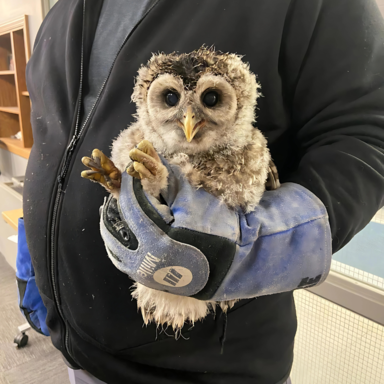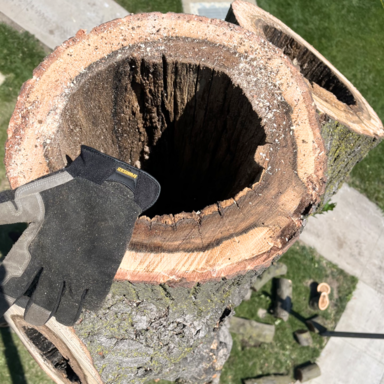
By Mikey Waller
In the first meeting of the morning, Health and Human Physiology DEO Gary Pierce glanced out of his office window and saw an extremely unusual view. A bird, frantic and persistent, attempting to scale the edge of the brick wall. With a closer look, he realized he was looking at a young owl who had fallen from a nest and ended up outside the academic entrance of the Field House. Due to the non-stop traffic of cars, bikes, and buses, as well as pedestrians heading to classes, work, appointments at the nearby UI Hospitals and Clinics, or getting a workout in, he asked the department’s Curriculum Coordinator, Mikey, to make some calls for help.
In order to get in contact with animal control and the Iowa Raptor Project, dispatch sent a police officer, who had previously assisted with birds in need of help including a large adult owl that got trapped in a soccer net. In this case, the young owl was not yet able to fly but could climb. The Iowa Raptor Project recommended leaving the owl alone and not interfering. After nightfall, climbing back up the tree would be significantly easier without the constant noise and traffic.
By 9:00 am, several other HHP staff jumped to help ease the owl’s distress. This included asking friends and neighbors with raptor experience for advice, making signs to inform those who walked by that the owl was not injured and should not be touched or chased, frequently checking to ensure the owl stayed in a safe area, and of course, naming her. After many failed attempts to climb the building, the newly named owl, Juniper, withdrew to the outside corner of Dr. Pierce’s office, wet from the rain and exhausted. However, she wasn’t alone. Her two siblings watched the commotion from the tree above and her parents could be spotted moving from tree to tree nearby, occasionally swooping down or calling out. Many HHP students and faculty stopped to ask questions and requested updates on Juniper after they returned from classes and meetings. Everyone was rooting for her return to the tree.

Later in the day, Juniper gained the energy for more attempts, including a light post and another small tree close to the one her siblings remained in. She got close, and those watching her progress held their breath as she almost made it. HHP staff made more signs and changed their locations outside the building as she moved around. In the afternoon, a student, who had not seen the signs and was concerned Juniper was injured and abandoned, made a call to the RARE Group (Raptor Advocacy Rehabilitation & Education). RARE, based in Iowa City and founded in 2015, is dedicated to the rescue, rehabilitation, and conservation of birds of prey throughout Iowa. HHP Emeritus Professor Kathy Janz plays a vital role in RARE’s organization and was more than willing to help however possible. When called, RARE volunteer Colin Shirk was available to come assess the situation. He found Juniper hiding in the bushes and HHP staff Abby, Edina, Lauren, Naomi, and Mikey were on standby to help. Concerned that Juniper would not make it up the tree due to the distressing environment and too many uncontrollable factors, Colin thought it best to place Juniper back in the tree. The staff welcomed Colin and Juniper into the main office and started making calls.

Just when it seemed like the efforts would be a dead end, Faculty Support Specialist Abby spotted a landscaping cart drive by and ran after it. She caught up with the landscaper and he was able to contact two UI tree trimmers. They arrived with a bucket truck and the willingness to take time from their workday to help Juniper. After a quick lesson from Colin, a tree trimmer held Juniper and placed her back in the tree. The group of HHP staff and UI facilities staff watched from below, relieved after six hours of collective efforts to keep her safe.
Juniper and her family remained safe in the trees until all three young owls learned how to fly. Unfortunately, Juniper’s oak tree was cut down in July for safety reasons after it endured storm damage, but it will always be remembered as the owl tree. The Health and Human Physiology Department is grateful to everyone who assisted in Juniper’s rescue: Iowa City Police, the Iowa Raptor Project, RARE and Colin, UI Facilities and Landscaping, and all staff, students, and faculty who were rooting for her!